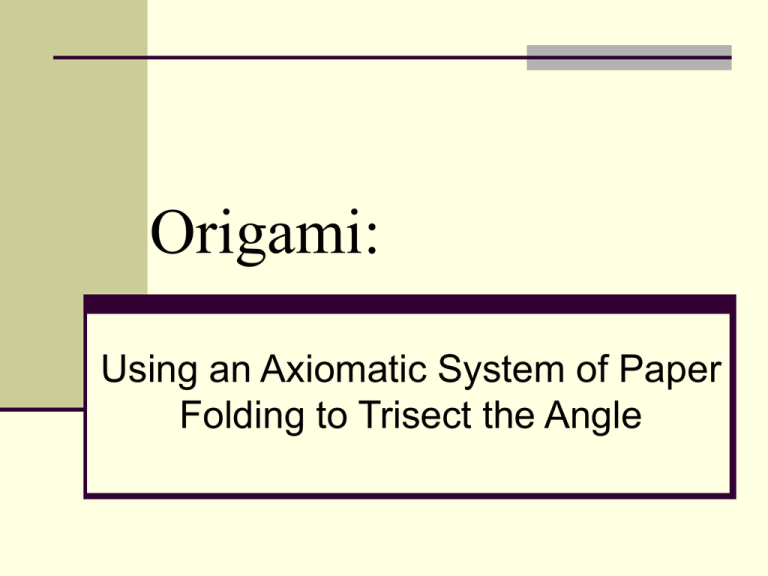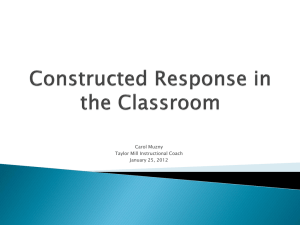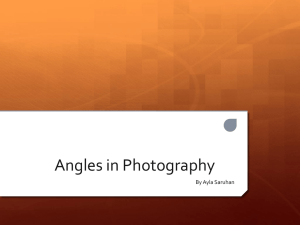Wojcik, K
advertisement

Origami: Using an Axiomatic System of Paper Folding to Trisect the Angle Agenda • Euclidean Geometry • Euclidean Constructions • Origami and the Axiomatic System of Humiaki Huzita • Trisecting the Angle • Proof of Trisection Euclid’s Postulates 1. Between any two distinct points, a segment can be constructed. 2. Segments can be extended indefinitely. Euclid’s Postulates (cont.) 3. Given two points and a distance, a circle can be constructed with the point as the center and the distance as the radius. 4. All right angles are congruent. Euclid’s Postulates (cont.) 5. Given two lines in the plane, if a third line l crosses the given lines such that the two interior angles on one side of l are less than two right angles, then the two lines if continued will meet on that side of l where the angles are less than two right angles. (Parallel Postulate) Euclidean Constructions Origami: Humiaki Huzita’s Axiomatic System 1. Given two constructed points P and Q, we can construct (fold) a line through them. 2. Given two constructed points P and Q, we can fold P onto Q. Origami: Humiaki Huzita’s Axiomatic System (cont.) 3. Given two constructed lines l1 and l2, we can fold l1 onto l2. 4. Given a constructed point P and a constructed line l, we can construct a perpendicular to l passing through P. Origami: Humiaki Huzita’s Axiomatic System (cont.) 5. Given two constructed points P and Q and a constructed line l, then whenever possible, the line through Q, which reflects P onto l, can be constructed. 6. Given two constructed points P and Q and two constructed lines l1 and l2, then whenever possible, a line that reflects P onto l1 and also reflects Q onto l2 can be constructed. Trisecting the Angle Step 1: Create (fold) a line m that passes through the bottom right corner of your sheet of paper. Let be the given angle. Step 2: Create the lines l1 and l2 parallel to the bottom edge lb such that l1 is equidistant to l2 and lb. Step 3: Let P be the lower left vertex and let Q be the intersection of l2 and the left edge. Create the fold that places Q onto m (at Q') and P onto l1 (at P'). Trisecting the Angle (cont.) Step 4: Leaving the paper folded, create the line l3 by folding the paper along the folded-over portion of l1. Step 5: Create the line that passes through P an P'. The angle trisection is now complete Proof of Angle Trisection We need to show that the triangles ∆PQ'R, ∆PP'R and ∆PP'S are congruent. Recall that l1 is the perpendicular bisector of the edge between P and Q. Then, → → Segment Q'P' is a reflection of segment QP and l3 is the extension of the reflected line l1. So l3 is the perpendicular bisector of Q'P'. ∆PQ'R = ∆PP'R (SAS congruence). Proof of Angle Trisection (cont.) Let R` be the intersection of l1 and the left edge. From our construction we see that RP`P is the reflection of R`PP` across the fold created in Step 3. → → → RP'P = R'PP' and ∆P'PR' = ∆PP'S (SSS congruence). ∆PP'S = ∆PP'R (SAS congruence). ∆PP'S = ∆PP'R = ∆PQ'R Other Origami Constructions • Doubling a Cube (construct cube roots) • The Margulis Napkin Problem • Quintinsection of an Angle









